According to general relativity the shape of spacetime determines the motions of objects while those objects determine (or at least influence) the shape of spacetime. Similarly in electrodynamics the fields determine the motions of charges in spacetime while the charges determine the fields in spacetime. This dualistic structure naturally arises when we replace action-at-a-distance with purely local influences in such a way that the interactions between "separate" objects are mediated by an entity extending between them. We must then determine the dynamical attributes of this mediating entity, e.g., the electromagnetic field in electrodynamics, or spacetime itself in general relativity.
However, many common conceptions regarding the nature and extension of these mediating entities are called into question by the apparently "non-local" correlations in quantum mechanics, as highlighted by EPR experiments. The apparent non-locality of these phenomena arises from the fact that although we regard spacetime as metrically Minkowskian, we continue to regard it as topologically Euclidean. As discussed in the preceding sections, the observed phenomena are more consistent with a completely Minkowskian spacetime, in which physical locality is directly induced by the pseudo-metric of spacetime. According to this view, spacetime operates on matter via interactions, and matter defines for spacetime the set of allowable interactions, i.e., consistent with conservation laws. A quantum interaction is considered to originate on (or be "mediated" by) the locus of spacetime points that are null-separated from each of the interacting sites. In general this locus is a quadratic surface in spacetime, and its surface area is inversely proportional to the mass of the transferred particle.
For two timelike-separated events A and B the mediating locus is a closed surface as illustrated below (with one of the spatial dimensions suppressed)
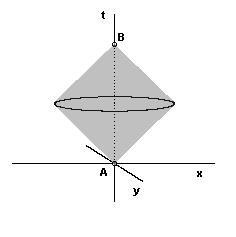
The mediating surface is shown here as a dotted circle, but in 4D spacetime it's actually a closed surface, spherical and purely spacelike relative to the frame of the interval AB. This type of interaction corresponds to the transit of massive real particles. Of course, relative to a frame in which A and B are in different spatial locations, the locus of intersection has both timelike and spacelike extent, and is an ellipse (or rather an ellipsoidal surface in 4D) as illustrated below
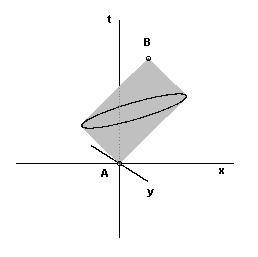
The surface is purely spacelike and isotropic only when evaluated relative to its rest frame (i.e., the frame of the interval AB), whereas this surface maps to a spatial ellipsoid, consisting of points that are no longer simultaneous, relative to any other co-moving frame. The directionally asymmetric aspects of the surface area correspond precisely to the "relativistic mass" components of the corresponding particles as a function of the relative velocity of the frames.
The propagation of a free massive particle along a timelike path through spacetime can be regarded as involving a series of surfaces, from which emanate inward-going "waves" along the nullcones in both the forward and backward direction, deducting the particle from the past focal point and adding it to the future focal point, as shown below for particles with different masses.
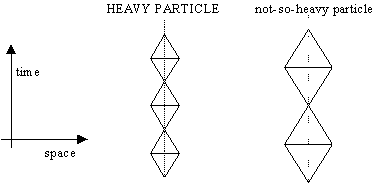
Recall that the frequency u of the de Broglie matter wave of a particle of mass m is
![]()
where px, py, pz are the components of momentum in the three directions. For a (relatively) stationary particle the momentums vanish and the frequency is just u = (mc2)/h sec-1. Hence the time per cycle is inversely proportional to the mass. So, since each cycle consists of an advanced and a retarded cone, the surface of intersection is a sphere (for a stationary mass particle) of radius r = h/mc, because this is how far along the null cones the wave propagates during one cycle. Of course, h/mc is just the Compton scattering wavelength of a particle of mass m, which characterizes the spatial expanse over which a particle tends to "scatter" incident photons in a characteristic way. This can be regarded as the effective size of a particle when "viewed" by means of gamma-rays. We may conceive of this effect being due to a high-energy photon getting close enough to the nominal worldline of the massive particle to interfere with the null surfaces of propagation, upsetting the phase coherence of the null waves and thereby diverting the particle from it's original path.
For a massless particle the quantum phase frequency is zero, and a completely free photon (if such a thing existed) would just be represented by an entire null-cone. On the other hand, real photons are necessarily emitted and absorbed, so they corresponds to bounded null intervals. Consistent with quantum electrodynamics, the quantum phase of photon does not advance while in transit between its emission and absorption (unlike massive particles). According to this view, the oscillatory nature of macroscopic electromagnetic waves arises from the advancing phase of the source, rather than from any phase activity of an actual photon.
The spatial volume swept out by a mediating surface is a maximum when evaluated with respect to it's rest frame. When evaluated relative to any other frame of reference, the spatial contraction causes the swept volume to be reduced. This is consistent with the idea that the effective mass of a particle is inversely proportional to the swept volume of the propagating surface, and it's also consistent with the effective range of mediating particles being inversely proportional to their mass, since the electromagnetic force mediated by massless photons has infinite range, whereas the strong nuclear force has a very limited range because it is mediated by massive particles. Schematics of a stationary and a moving particle are shown below.
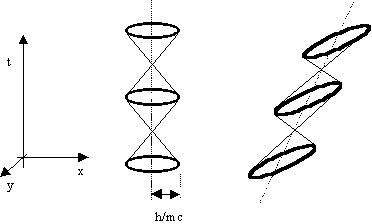
This is the same illustration that appeared in the discussion of Lorentz's "corresponding states" in Section 1.5, although in that context the shells were understood to be just electromagnetic waves, and Lorentz simply conjectured that all physical phenomena conform to this same structure and transform similarly. In a sense, the relativistic Schrodinger wave equation and Dirac's general argument for light-like propagation of all physical entities based on the combination of relativity and quantum mechanics (as discussed in Section 9.10) provide the modern justification for Lorentz's conjecture. Looking back even further, we see that by conceiving of a particle as a sequence of surfaces of finite extent, it is finally possible to answer Zeno's question about how a moving particle differs from a stationary particle in "a single instant". The difference is that the mediating surfaces of a moving particle are skewed in spacetime relative to those of a stationary particle, corresponding to their respective planes of simultaneity.
Some quantum interactions involve more than two particles. For example, if two coupled particles separate at point A and interact with particles at points B and C respectively, the interaction (viewed straight from the side) looks like this:
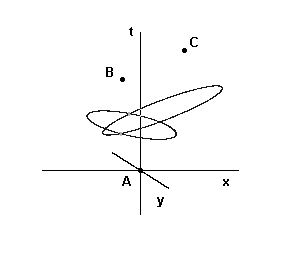
The mediating surface for the pair AB intersects with the mediating surface for AC at the two points of intersection of the dotted circles, but in full 4D spacetime the intersection of the two mediating spheres is a closed circle. (It's worth noting that these two surfaces intersect if and only if B and C are spacelike separated. This circle enforces a particular kind of consistency on any coherent waves that are generated on the two mediating surfaces, and are responsible for "EPR" type correlation effects.)
The locus of null-separated points for two lightlike-separated events is a degenerate quadratic surface, namely, a straight line as represented by the segment AB below:
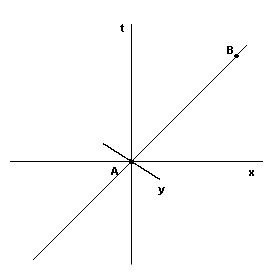
The "surface area" of this locus (the intersection of the two cones) is necessarily zero, so these interactions represent the transits of massless particles. For two spacelike-separated events the mediating locus is a two-part hyperboloid surface, represented by the hyperbola shown at the intersection of two null cones below
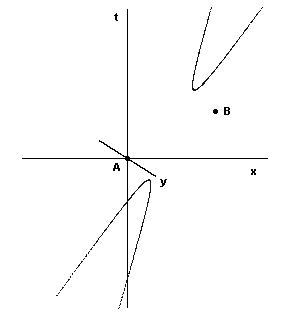
This hyperboloid surface has infinite area, which suggests that any interaction between spacelike separated events would correspond to the transit of an infinitely massive particle. On this basis it seems that these interactions can be ruled out. There is, however, a limited sense in which such interactions might be considered. Recall that a pseudosphere can be represented as a sphere with purely imaginary radius. It's conceivable that observed interactions involving virtual (conjugate) pairs of particles over spacelike intervals (within the limits imposed by the uncertainty relations) may correspond to hyperboloid mediating surfaces.
(It's also been suggested that in a closed universe the "open" hyperboloid surfaces might need to be regarded as finite, albeit extremely huge. For example, they might be 35 orders of magnitude larger than the mediating surfaces for timelike interactions. This is related to vague notions that "h" is in some sense the "inverse" of the size of a finite universe. In a much smaller closed universe (as existed immediately following the big bang) there may be have been an era in which the "hyperboloid" surfaces had areas comparable to the ellipsoid surfaces, in which case the distinction between spacelike and time-like interactions would have been less significant.)
An interesting feature of this interpretation is that, in addition to the usual 3+1 dimensions, spacetime requires two more "curled up" dimensions of angular orientation to represent the possible directions in space. The need to treat these as dimensions in their own right arises from the non-transitive topology of the pseudo-Riemannian manifold. Each point [t,x,y,z] actually consists of a two-dimensional orientation space, which can be parameterized (for any fixed frame) in terms of ordinary angular coordinates q and f . Then each point in the six-dimensional space with coordinates [x,y,z,t,q ,f ] is a terminus for a unique pair of spacetime rays, one forward and one backward in time. A simple mechanistic visualization of this situation is to imagine a tiny computer at each of these points, reading its input from the two rays and sending (matched conservative) outputs on the two rays. This is illustrated below in the xyt space:
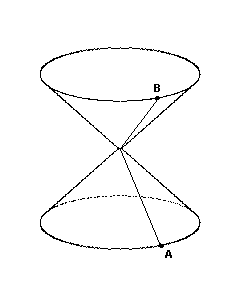
The point at the origin of these two views is on the mediating surface of events A and B. Each point in this space acts purely locally on the basis of purely local information. Specifying a preferred polarity for the two null rays terminating at each point in the 6D space, we automatically preclude causal loops and restrict information flow to the future null cone, while still preserving the symmetry of wave propagation. (Note that an essential feature of spacetime mediation is that both components of a wave-pair are "advanced", in the sense that they originate on a spherical surface, one emanating forward and one backward in time, but both converge inward on the particles involved in the interaction.
According to this view, the "unoccupied points" of spacetime are elements of the 6D space, whereas an event or particle is an element of the 4D space (t,x,y,z). If effect an event is the union of all the pairs of rays terminating at each point (x,y,z). We saw in Chapter 3.5 that the transformations of q and f under Lorentzian boosts are beautifully handled by linear fractional functions applied to their stereometric mappings on the complex plane.
One common objection to the idea that quantum interactions occur locally between null-separated points is based on the observation that, although every point on the mediating surface is null-separated from each of the interacting events, they are spacelike-separated from each other, and hence unable to communicate or coordinate the generation of two equal and opposite outgoing quantum waves (one forward in time and one backward in time). The answer to this objection is that no communication is required, because the "coordination" arises naturally from the context. The points on the mediating locus are not communicating with each other, but each of them is in receipt of identical bits of information from the two interaction events A and B. Each point responds independently based on its local input, but the combined effect of the entire locus responding to the same information is a coherent pair of waves.
Another objection to the "spacetime mediation" view of quantum mechanics is that it relies on temporally symmetric propagation of quantum waves. Of course, this objection can't be made on strictly mathematical grounds, because both Maxwell's equations and the (relativistic) Schrodinger equation actually are temporally symmetric. The objection seems to be motivated by the idea that the admittance of temporally symmetric waves automatically implies that every event is causally implicated in every other event, if not directly by individual interactions then by a chain of interactions, resulting in a non-sensical mess. However, as we've seen, the spacetime mediation view leads naturally to the conclusion that interactions between spacelike-separated events are either impossible or else of a very different (virtual) character than interactions along time-like intervals. Moreover, the stipulation of a preferred polarity for the ray pairs terminating at each point is sufficient to preclude causal loops.